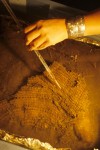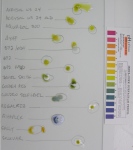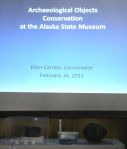Noontime Presentation at the Alaska State Museum
February 16, 2011
This was a lecture for the general public, part of our brown bag lunch lecture series this winter. Approximately 40 people attended, and about 8 people stuck around and asked me questions for another hour and a half. Here are some of the images from the lecture and the general points I tried to make. Hover with your cursor for more info. Click on the image to enlarge. You might be able to click again and enlarge even more. Hit the back button to return to the article.
- Artifacts
- Artifacts glued into box
- Camera taken from a shipwreck by a diver, did not receive prompt conservation
- Photomicrograph of new spruce root
- Polyethylene Glycol (PEG)
- Fish weir stakes from Baranof Island
- Tawah Creek Basket ASM 2006-31-1
- Center or “start” of the Thorne River Basket, over 5,000 years old. ASM 94-31-1
- South Baranof Island Basket, over 4,000 years old. ASM 95-12-1
- Montana Creek Fish Trap, over 500 years old, ASM TD95-32
- Montana Creek Fish Trap during treatment
- Montana Creek Fish Trap during mount making
- Bone Brush from the Torrent shipwreck, 1868 ASM 2008-11-24
- Two portholes from the Torrent Shipwreck, ASM accession 2008-11
- Suggested bronze disease diagram
- Three views of the Mountain Howitzer from the Torrent shipwreck, 1868. ASM 2008-11-83
- Torrent shipwreck howitzer, ASM 2008-11-83 during treatment
- Ceramic mark from dish found on the Torrent shipwreck. ASM accession 2008-11
- Wheel hub from the Kad’yak shipwreck, 1860. ASM 2008-11-12
- Kad’yak wheel hub in 2004, photo by Frank Cantelas
- Wheel hub after treatment with silicone oil
- Conservator Ellen Carrlee, Alaska State Archaeologist Dave McMahan, NOAA conservator Wayne Lusardi and NOAA diver/archaeologist Tane Casserly discuss Torrent shipwreck items. Photo by John Adams.
- Weaver Mary Lou King (left), Tlingit-Haida weaver Janice Criswell (right) and curator/artist Steve Henrikson (not pictured) created the replica of the fish trap. Photo by Steve Henrikson
- Exhibit designer Bob Banghart and conservator Ellen Carrlee worked in lockstep to support and preserve the fish trap.
- Tlingit-Haida weaver and scholar Janice Criswell cleaning an ancient basket. Photo by Steve Henrikson
- Adhesive testing for labels used on archaeological materials
- Label adhesives tested on bone at the Alaska State Museum.
- Adhesive testing on pennies
- Adhesives tested on polished copper show artist acrylics causing a reaction
- Red is acidic, and blue is basic. Acrylic gels are slightly basic, but this testing shows Rhoplex is quite basic.
The discussion also included some of the criteria we look for when choosing appropriate treatment materials. These include:
Future Analysis: some materials interfere with microanalysis. We are also concerned with potential kinds of analysis available in the future. Analysis includes examination by scholars. For example, a sail historian told me he needs a fragment of ancient waterlogged sail to remain slightly flexible so he can peek inside the seam and see important clues in the construction and stitching.
Future Treatment: There may be better treatment options in the future, or the treatments we use now might not last as long as we would like. For these reasons, reversibility of the treatment is desired, or at least the potential for re-treatment with something else.
Appropriate Appearance: For study and display, it is important that an artifact look the way curators and other experts say it should.
Age Well: In the museum, we want to preserve these artifacts for hundreds, even thousands of years. The materials we use on artifacts ought to last a long time and not harm the artifact years down the road.
Chemically Compatible: Conservators need to understnad chemistry to know if a proposed treatment material is chemically comaptible with the artifact
Non-Toxic: Conservators don’t want to compromise their health by using toxic materials to treat artifacts. We also don’t want to create poisonous collections. And of course toxic materials need to go somewhere when we are done with them, and we don’t want to pollute the environment.
I concluded the lecture with a brief discussion of the agents of deterioration (light, temperature, humidity, pollutants, handling, pests, and disaster) because no conservation lecture is really complete without touching on them, and the concept of “Agents of Deterioration” is a good one to help the public better care for treasures in their personal collections. Hmmm, that would be a good blog posting, actually….



































 Posted by ellencarrlee
Posted by ellencarrlee